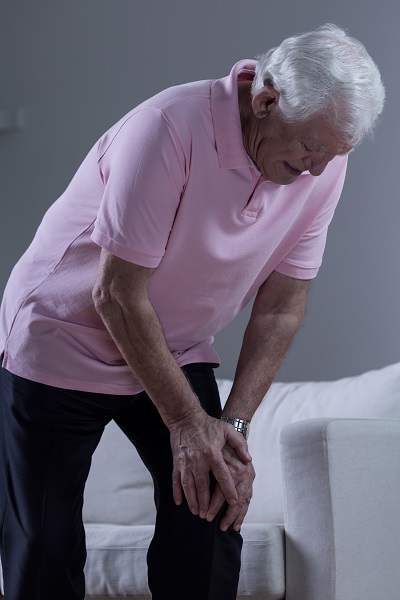ARTHRITIS is a very common condition which causes pain and inflammation in one or more affected joints. Although it can affect people at every stage of life, including children, it is usually age-related.
There are several types of arthritis, the most common being ‘osteoarthritis’, which is also known as ‘wear and tear arthritis’. As that name suggests, it is caused by general wear and tear on a joint and initially affects the smooth cartilage lining, leading to pain, stiffness and difficulty in moving.
 Weight-bearing joints such as hips and knees are usually affected, although it is also common in the hands and spine. Athletes can suffer from osteoarthritis earlier in life due to the extra ‘wear and tear’ their joints suffer through sport.
Weight-bearing joints such as hips and knees are usually affected, although it is also common in the hands and spine. Athletes can suffer from osteoarthritis earlier in life due to the extra ‘wear and tear’ their joints suffer through sport.
The second most common type is ‘rheumatoid arthritis’, in which the body’s own immune system targets affected joints, leading to pain and swelling. In both these two main types, women are more likely to be affected than men, and there are many more types of arthritis and related conditions.
Whatever type of arthritis you have, living with the condition on a daily basis can be difficult and painful, which in turn takes a toll on mental health. The symptoms can be eased with medication and ultimately through surgery, such as hip or knee replacement, but there are also lifestyle choices which can help with managing arthritis day-to-day. Here are some helpful tips:
Healthy eating: If you have arthritis it’s very important to stick to a healthy and balanced diet, for two main reasons. Firstly, a healthy diet will provide the nutrients and vitamins your body needs to function well. Secondly, it will help you maintain or achieve a healthy weight. Being overweight puts extra stress on painful arthritic joints and potentially makes them worse. Losing weight can deliver tangible benefits, both in pain management and improved mobility. Your doctor might refer you for specialist dietary advice, or you could join a weight loss group with a plan based on a healthy and balanced diet. Avoid ‘fad diets’ which are difficult to sustain in the longer-term and may not deliver the nutrients your body needs.
Exercise: If your arthritis causes you pain when moving it’s tempting to become more sedentary and exercise less, but that’s the wrong way to go. While it might seem counterintuitive, being active can help to reduce and prevent pain, improving your range of movement and joint mobility. Other benefits include increased muscle strength (supporting affected joints), reduced stiffness and improved energy levels. It’s important to choose the right type and level of exercise and your doctor or medical team should be able to advise you on this. Swimming or ‘aqua aerobics’ are often recommended, as being immersed in water helps support painful joints. Many arthritis charities and support organisations devote sections of their websites to exercising with arthritis. Combined with a healthy diet, exercise will reinforce a structured weight loss plan.
Joint care: Looking after your joints to protect them from further damage is vital if you have arthritis (and if you don’t!). Adopting different ways of doing things and even just sitting with good posture while watching TV or reading can all help. For example, using a rucksack on your back will spread the load far better than a conventional shopping bag. Try to use your larger, stronger joints as levers, such as pushing against a heavy door with your shoulder or back rather than stressing your hand and wrist. You should also move around regularly and not stay in the same position for too long.
Adapt your home: On the same principle of not stressing painful joints, there are several ways to change your home environment to better suit living with arthritis. Having high-seat or riser chairs can help, choosing pens or other tools with a wide, soft grip or installing grab rails in a key location. There is a huge range of kitchen gadgets designed for people who struggle to grip or lift – everything from jar openers to kettle cradles. If your arthritis is severe, you might qualify for a home visit by an ‘occupational therapist’ who could offer professional advice on adapting your living space or using specially-designed equipment to make your life easier.
• One of the biggest challenges for people with arthritis is using the stairs in their home, which can impact heavily on painful weight-bearing joints. Climbing the stairs can be an unwelcome and tiring ordeal, but descending is just as bad, jolting or jarring painful and inflamed joints. As well as the pain and discomfort, it increases the risk of a potentially catastrophic fall on the stairs.
That risk can be eliminated by investing in an Acorn Stairlift, one of the most life-enhancing home adaptations for anyone living with arthritis. It enables you to move up and down stairs in safety and comfort whenever you need to, retaining your independence at home without the need to set up ground floor sleeping or bathroom facilities or consider moving to a single-storey dwelling.
Arthritis is the number one reason why people invest in an Acorn Stairlift. For more information on how it could change your life, call Acorn today on Freephone 0808 223 4871 or click on the green ‘Quick Free Quote’ button at the top right of this page.
You’ll find much more information about arthritis on the website of leading UK charity Versus Arthritis. To visit the website, click here.
